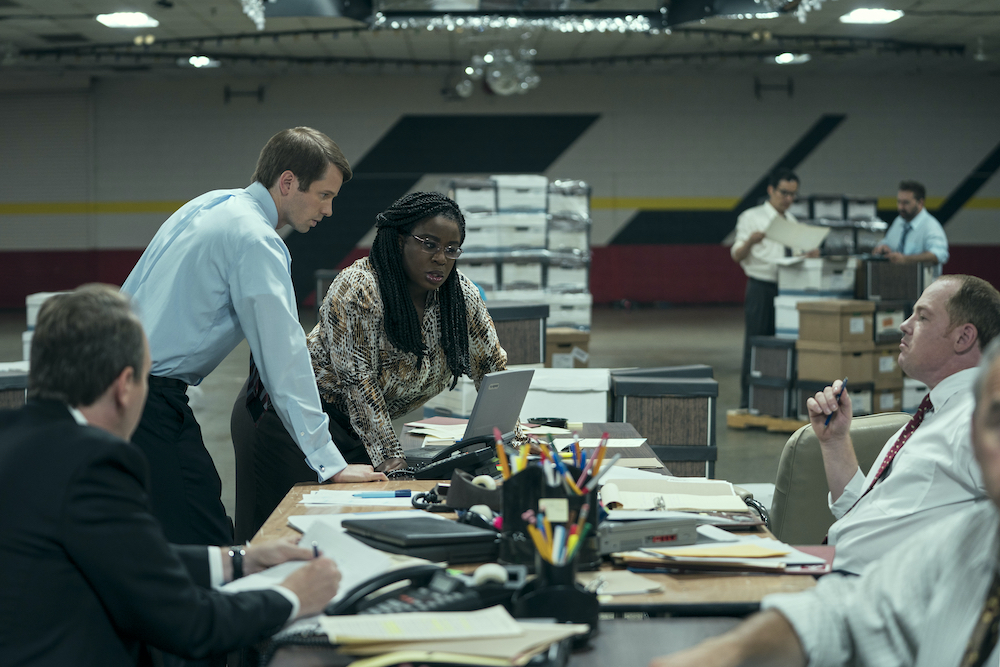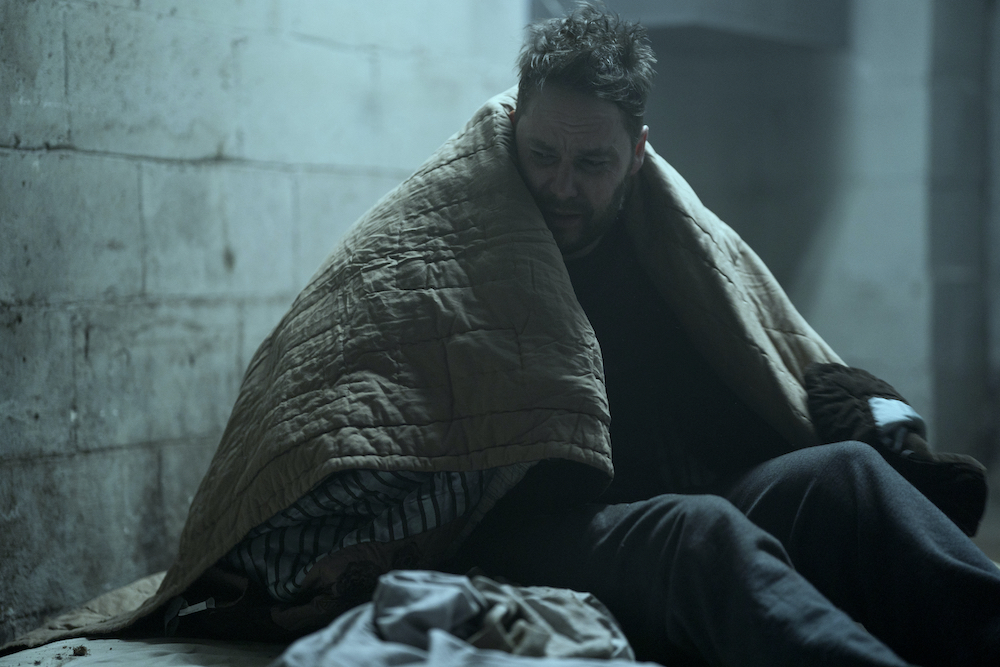Netflix’s ‘Painkiller’ is a fictionalized retelling of the true events surrounding the opioid crisis. Unfolding from the point of view of different characters, the show presents a shocking and heartbreaking tale that exposes the hideous nature of the pharma companies that are focused only on making money. We follow the events from the perspective of Richard Sackler, who is focused on making as much money as possible because he thinks this is how he will cement his uncle’s legacy.
In contrast to this is Glen Kryger, a common man trying to make ends meet for his family, but his whole life is derailed after a tragic accident lands him a prescription for OxyContin. In between this, an investigator is trying to bring Purdue Pharma and Richard Sackler to their knees by exposing their nefarious schemes. Here’s what happens to them in the end. SPOILERS AHEAD!
Painkiller Synopsis

Edie Flowers sits down for a deposition where she is asked to tell her story of how she got involved in the investigation surrounding Purdue Pharma from the beginning. She reveals that she wasn’t aware of OxyContin at the point and was looking into something else when she discovered that doctors had been prescribing insane amounts of OxyContin to their patients. What started as a curiosity turned into a full-blown investigation when Edie realized that hundreds of people were dying because of the highly unregulated use of the drugs.
Parallel to this, we follow the story of Richard Sackler, who is put in charge of the company after the death of his uncle, Arthur Sackler, who started the trend of making money out of selling and marketing prescription drugs, no matter what impact they had on the customer. With Arthur gone and the entire business in shambles, Richard comes up with the idea of OxyContin. From its creation to FDA approval to marketing, he leaves no stone unturned to make OxyContin a success for the company. He succeeds, but this leads to an opioid crisis in the country.
To sell the drugs, pharmaceutical sales reps like Shannon Schaeffer are given incentives, which they forward to the doctors, pushing them to increase the dosage of their patients, not considering what effect it might have. We see the repercussions of this greed in the life of Glen Kryger. Glen suffers from chronic back pain after an accident at his workplace, so the doctor prescribes him OxyContin. At first, Glen is advised to take one pill every 12 hours, but slowly, the dosage is increased, and Glen becomes addicted to it.
Painkiller Ending: Does Glen Die?

Like Glen, hundreds of thousands of people are affected by OxyContin, as it has become the preferred choice of drug for addicts. The patients get hooked to it because of the prescriptions, but soon, youngsters and anyone looking for a quick fix to their desire of getting high turn towards OxyContin. People, especially teenagers, start faking their condition to get a prescription for the drug.
For Glen, the situation gets worse as he gets more and more dependent on OxyContin. The problem comes to light when he is so high that he bites his finger while eating and then passes out. At first, he vows to get rid of the drug and flushes an entire bottle down the toilet. The next day, however, when the back pain bothers him and he starts to have withdrawal effects from the drugs, he returns to the doctor to get a prescription. This is a temporary relief because he quickly runs out of pills.
At first, his wife is supportive and tries to help him through the relapse. But she cuts off ties with him when he gets high again instead of bringing his stepson home. Glen hits a low when he sells the stuff from the shop to get money to get a prescription because the doctor refuses to write one. He is robbed of all his money and asks Tyler to get him the money or the Oxy from somewhere. Eventually, he decides to get clean again, and this time, he becomes one month sober.

Things start to improve as Glen is welcomed into his home again and spends time with his wife and daughter. However, one night, he finds his neighbors in the motel (where he’d been temporarily staying since the separation) passed out. They have some Oxy lying around. Glen takes it and falls off the wagon, this time much harder than before. He overdoses and is found by passersby. They call 911, but someone comments that Glen is not breathing anymore, which suggests he might be dead. However, this is not really confirmed. The paramedics might arrive just in time to help him.
The show intentionally leaves us in the dark about Glen’s fate, turning our attention to the plight of hundreds of thousands of people who have been affected by the opioid epidemic, with their lives hanging in the balance because the system failed to regulate the drugs that were supposed to help them.
What Happens to Edie Flowers?

Working as an investigator for the US Attorney’s office, Edie Flowers thought she was fighting the good fight. She thought she could make a difference, and with this resolve and enthusiasm, she jumped into the fight against Purdue Pharma and Richard Sackler. She knew how drug abuse could break a family and destroy lives, which is why she was more determined than anyone else to make Purdue pay for their actions. In the end, however, she realized the system was pitted against her.
At the deposition, Edie reveals her entire story about discovering OxyContin and working hard to make a case against Purdue and Sackler. Despite doing everything right and despite all the right intentions, she couldn’t succeed because people like Sackler would always have more power and influence than her. She worked for months to build a case against him, and he unraveled it with one phone call to the people much higher up the ladder.
Edie confesses that the settlement reached between Purdue and Brownlee, who was helpless in front of his superiors, was the last straw for her. She accepted that the system was rigged to make people like her fail. So, she left her job at the US Attorney’s office and moved away. She made peace with her brother, whom she blamed for their mother’s death. He’s out of prison now, and he and Edie live together, making up for lost time. She laments that she couldn’t make Purdue and Sackler pay, but she is more focused on other things now, things that are in her control.
Is Purdue Pharma Prosecuted? Do They Stop Making OxyContin?

Edie Flowers and John Brownlee built a case against Purdue Pharma, but the settlement meant that all they discovered about the company and its top executives would be sealed. It wouldn’t be touched again, which meant the company was free. They promised to take necessary steps to combat the opioid crisis, but the way Purdue’s sales soared and it kept making money, it was clear that nothing actually came out of the settlement.
Years later, Edie is called for a deposition where she discovers that the prosecution got Richard Sackler this time. It means that they have Purdue, and there is scope for settlement, which means Sackler and Purdue will have to answer for their actions. It’s a hopeful ending, but the title cards suggest otherwise. The Sackler family never owned up to their responsibility in the crisis, even after they decided to forgo the company.
In 2007, Purdue laud over $600 million in fines and focused on making changes in OxyContin and its marketing approach to help with the crisis. They changed the formula, but it comes with its own side effects. According to a New York Times article, it is known to have hepatitis C and other infections as its side effects. This new formula is also believed to have turned the opioid crisis towards heroin.
In 2021, the Sackler family, which had filed for bankruptcy following the new investigation, got immunity from all lawsuits filed against them. They forfeited their ownership of Purdue Pharma and agreed to pay around $4.3 billion. This was a part of the bankruptcy settlement, which granted them “global peace,” shrugging off any liability they might be held to. It releases them “from liability for harm caused by OxyContin and other opioids.” This extends to their associates and other companies under the family’s control. However, they refused to accept any responsibility or guilt in the crisis.

